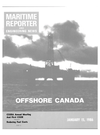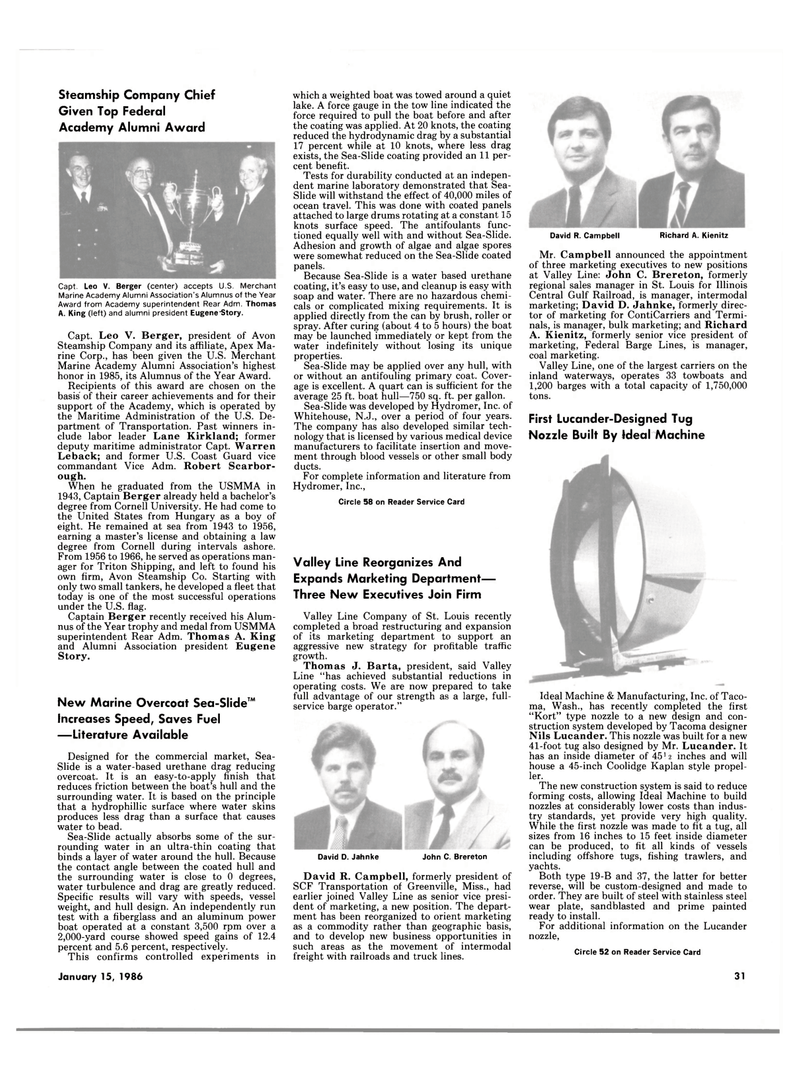
Page 29: of Maritime Reporter Magazine (January 15, 1986)
Read this page in Pdf, Flash or Html5 edition of January 15, 1986 Maritime Reporter Magazine
Steamship Company Chief
Given Top Federal
Academy Alumni Award
Capt. Leo V. Berger (center) accepts U.S. Merchant
Marine Academy Alumni Association's Alumnus of the Year
Award from Academy superintendent Rear Adm. Thomas
A. King (left) and alumni president Eugene-Story.
Capt. Leo V. Berger, president of Avon
Steamship Company and its affiliate, Apex Ma- rine Corp., has been given the U.S. Merchant
Marine Academy Alumni Association's highest honor in 1985, its Alumnus of the Year Award.
Recipients of this award are chosen on the basis' of their career achievements and for their support of the Academy, which is operated by the Maritime Administration of the U.S. De- partment of Transportation. Past winners in- clude labor leader Lane Kirkland; former deputy maritime administrator Capt. Warren
Leback; and former U.S. Coast Guard vice commandant Vice Adm. Robert Scarbor- ough.
When he graduated from the USMMA in 1943, Captain Berger already held a bachelor's degree from Cornell University. He had come to the United States from Hungary as a boy of eight. He remained at sea from 1943 to 1956, earning a master's license and obtaining a law degree from Cornell during intervals ashore.
From 1956 to 1966, he served as operations man- ager for Triton Shipping, and left to found his own firm, Avon Steamship Co. Starting with only two small tankers, he developed a fleet that today is one of the most successful operations under the U.S. flag.
Captain Berger recently received his Alum- nus of the Year trophy and medal from USMMA superintendent Rear Adm. Thomas A. King and Alumni Association president Eugene
Story.
New Marine Overcoat Sea-Slide™
Increases Speed, Saves Fuel —Literature Available
Designed for the commercial market, Sea-
Slide is a water-based urethane drag reducing overcoat. It is an easy-to-apply finish that reduces friction between the boat's hull and the surrounding water. It is based on the principle that a hydrophillic surface where water skins produces less drag than a surface that causes water to bead.
Sea-Slide actually absorbs some of the sur- rounding water in an ultra-thin coating that binds a layer of water around the hull. Because the contact angle between the coated hull and the surrounding water is close to 0 degrees, water turbulence and drag are greatly reduced.
Specific results will vary with speeds, vessel weight, and hull design. An independently run test with a fiberglass and an aluminum power boat operated at a constant 3,500 rpm over a 2,000-yard course showed speed gains of 12.4 percent and 5.6 percent, respectively.
This confirms controlled experiments in which a weighted boat was towed around a quiet lake. A force gauge in the tow line indicated the force required to pull the boat before and after the coating was applied. At 20 knots, the coating reduced the hydrodynamic drag by a substantial 17 percent while at 10 knots, where less drag exists, the Sea-Slide coating provided an 11 per- cent benefit.
Tests for durability conducted at an indepen- dent marine laboratory demonstrated that Sea-
Slide will withstand the effect of 40,000 miles of ocean travel. This was done with coated panels attached to large drums rotating at a constant 15 knots surface speed. The antifoulants func- tioned equally well with and without Sea-Slide.
Adhesion and growth of algae and algae spores were somewhat reduced on the Sea-Slide coated panels.
Because Sea-Slide is a water based urethane coating, it's easy to use, and cleanup is easy with soap and water. There are no hazardous chemi- cals or complicated mixing requirements. It is applied directly from the can by brush, roller or spray. After curing (about 4 to 5 hours) the boat may be launched immediately or kept from the water indefinitely without losing its unique properties.
Sea-Slide may be applied over any hull, with or without an antifouling primary coat. Cover- age is excellent. A quart can is sufficient for the average 25 ft. boat hull—750 sq. ft. per gallon.
Sea-Slide was developed by Hydromer, Inc. of
Whitehouse, N.J., over a period of four years.
The company has also developed similar tech- nology that is licensed by various medical device manufacturers to facilitate insertion and move- ment through blood vessels or other small body ducts.
For complete information and literature from
Hydromer, Inc.,
Circle 58 on Reader Service Card
Valley Line Reorganizes And
Expands Marketing Department—
Three New Executives Join Firm
Valley Line Company of St. Louis recently completed a broad restructuring and expansion of its marketing department to support an aggressive new strategy for profitable traffic growth.
Thomas J. Barta, president, said Valley
Line "has achieved substantial reductions in operating costs. We are now prepared to take full advantage of our strength as a large, full- service barge operator."
David D. Jahnke John C. Brereton
David R. Campbell, formerly president of
SCF Transportation of Greenville, Miss., had earlier joined Valley Line as senior vice presi- dent of marketing, a new position. The depart- ment has been reorganized to orient marketing as a commodity rather than geographic basis, and to develop new business opportunities in such areas as the movement of intermodal freight with railroads and truck lines.
David R. Campbell Richard A. Kienitz
Mr. Campbell announced the appointment of three marketing executives to new positions at Valley Line: John C. Brereton, formerly regional sales manager in St. Louis for Illinois
Central Gulf Railroad, is manager, intermodal marketing; David D. Jahnke, formerly direc- tor of marketing for ContiCarriers and Termi- nals, is manager, bulk marketing; and Richard
A. Kienitz, formerly senior vice president of marketing, Federal Barge Lines, is manager, coal marketing.
Valley Line, one of the largest carriers on the inland waterways, operates 33 towboats and 1,200 barges with a total capacity of 1,750,000 tons.
First Lucander-Designed Tug
Nozzle Built By ideal Machine
Ideal Machine & Manufacturing, Inc. of Taco- ma, Wash., has recently completed the first "Kort" type nozzle to a new design and con- struction system developed by Tacoma designer
Nils Lucander. This nozzle was built for a new 41-foot tug also designed by Mr. Lucander. It has an inside diameter of 4512 inches and will house a 45-inch Coolidge Kaplan style propel- ler.
The new construction system is said to reduce forming costs, allowing ideal Machine to build nozzles at considerably lower costs than indus- try standards, yet provide very high quality.
While the first nozzle was made to fit a tug, all sizes from 16 inches to 15 feet inside diameter can be produced, to fit all kinds of vessels including offshore tugs, fishing trawlers, and yachts.
Both type 19-B and 37, the latter for better reverse, will be custom-designed and made to order. They are built of steel with stainless steel wear plate, sandblasted and prime painted ready to install.
For additional information on the Lucander nozzle,
Circle 52 on Reader Service Card
January 15, 1986 31

 28
28

 30
30
